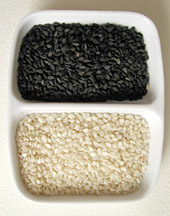About Sesame seeds[]
Sesame is grown primarily for its oil-rich seeds, which come in a variety of colors, from cream-white to charcoal-black. In general, the paler varieties of sesame seem to be more valued in the West and Middle East, while the black varieties are prized in the Far East. The small sesame seed is used whole in cooking for its rich nutty flavour (although such heating damages their healthful polyunsaturated fats), and also yields sesame oil.
"Goma" is Japanese for sesame seed. Sbiro goma is unhulled white sesame seed, muki goma is hulled white seed and kuro goma is black sesame seed. Goma abura is sesame seed oil. All four products are available in Asian markets.
Black sesame seeds[]
Black sesame appears frequently in Chinese, Japanese and Korean dishes. Black sesame seeds are an extremely good source of calcium; studies have shown that one gram of seeds contains approximately 85 milligrams of calcium. Black sesame seeds also have high amounts of protein, phosphorous, iron and magnesium.
White sesame seeds[]
White sesame seeds are more commonly used in Western dishes. The seeds have a nutty, slightly sweet flavor and are usually white or beige in color. They can also be ground to make tahini.
